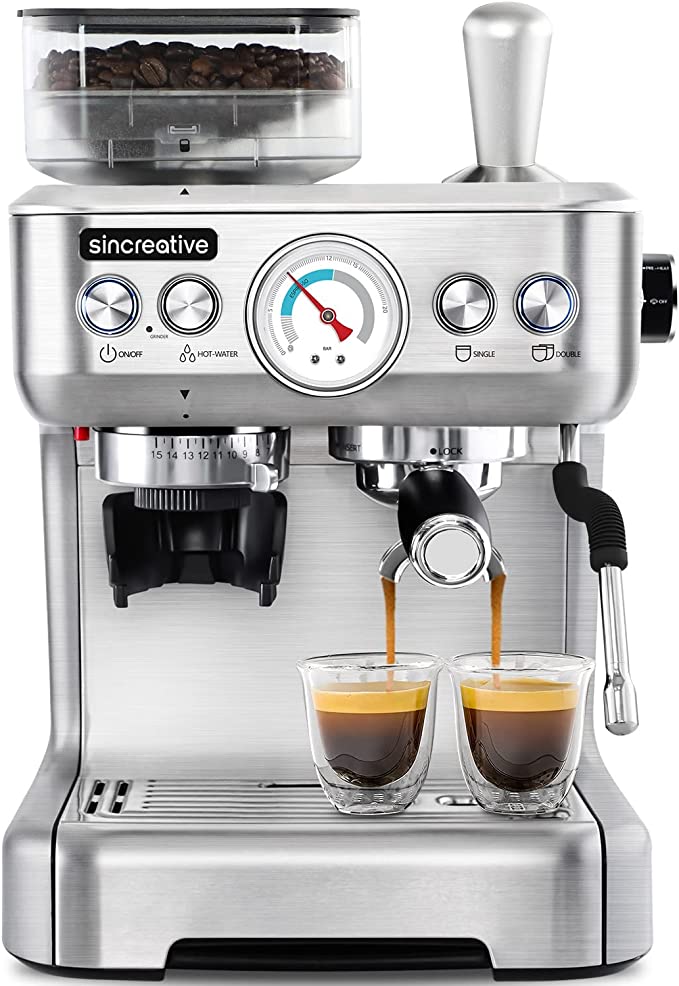Your First Espresso Machine: A Beginner's Guide to the Amaste AC-517E
Update on Nov. 2, 2025, 8:21 p.m.
So, you did it. You brought home that beautiful, matcha-green machine that promises to turn your kitchen into your own personal café. You’ve unboxed the Amaste AC-517E Espresso Machine, laid out all the shiny tools from the Barista Kit, and now you’re standing there, filled with a mix of excitement and a tiny bit of terror, thinking: “Okay… now what?”
Deep breath. As your coffee mentor, I’m here to be the guide that the instruction booklet perhaps wasn’t. Forget the confusing diagrams. Today is your first day of barista school, and I promise you, by the end of this, you will have made a delicious cup of coffee that you crafted with your own hands. You didn’t just buy an appliance; you bought a new, incredibly rewarding hobby. Let’s get started.

Your First Mission: Taming the Grinder
This is the most important step, and the one that trips up most beginners. The built-in conical burr grinder is your most powerful tool. Its job is to turn whole beans into uniformly sized particles. Getting this right is 90% of the battle.
The machine gives you 15 grind settings, which can feel overwhelming. So, here is your first, and most crucial, pro-tip:
Your Starting Point: Set the dial on the grinder to setting 8. This is a solid middle ground that will serve as our starting point for “dialing in.”
Now, let’s grind. Place the portafilter (the handle with the metal basket) into the clever hands-free cradle, push it in gently, and let the grinder fill the basket until it’s slightly mounded. Use your tamper to press down firmly and evenly. You’re now ready for the main event.
Your Cockpit: Using the Pressure Gauge to Pull the Perfect Shot
That big, beautiful pressure gauge on the front isn’t just for looks. It’s your cockpit instrument, your guide to a perfect extraction. It tells you the story of what’s happening inside the machine.
Our goal is to have the needle land in the “Espresso Range” (typically between 9 and 12 bars) for about 25-30 seconds.
- Lock and Load: Twist the portafilter into the machine until it’s snug.
- Pre-Infusion: Press the single or double shot button. You’ll hear the machine start, but coffee won’t flow immediately. This is the low-pressure pre-infusion at work. It’s gently soaking the coffee puck, preparing it for the main extraction and preventing bitter flavors. It’s a high-end feature, and it’s your secret weapon.
- Watch the Gauge: After a few seconds, the pressure will ramp up. Watch the needle.
- Needle doesn’t reach the Espresso Range? Your grind is too coarse. The water is flowing through too easily. For your next shot, adjust the grinder to a finer setting (e.g., to 7).
- Needle shoots past the Espresso Range and coffee barely drips out? Your grind is too fine. The water is struggling to get through. For your next shot, adjust to a coarser setting (e.g., to 9).
When you see a steady, honey-like stream of espresso flowing and the needle is happily in the middle of that espresso range, you’ve done it. You’ve dialed in your first shot.

The Art of Steam: Your First Silky Latte
Now, let’s turn that perfect shot into a café-quality latte. The steam wand can be intimidating, but you’ve got this.
- Start Cold: Fill your stainless steel milk pitcher (from your barista kit!) with cold milk, about halfway up.
- Purge the Wand: Before you start, turn the steam on for a few seconds into the drip tray. This clears out any condensed water.
- The Stretch: Submerge the tip of the wand just below the surface of the milk and turn the steam on. You should hear a gentle “tearing” or hissing sound. This is air being introduced. Let it stretch until the milk has increased in volume by about a third.
- The Vortex: Plunge the wand deeper into the milk, angling the pitcher to create a swirling vortex. This is the magic step that breaks down big bubbles into silky, smooth microfoam.
- Feel the Heat: Keep the vortex going until the bottom of the pitcher is just a little too hot to comfortably hold. Turn the steam off before you remove the wand from the milk.
- Groom and Pour: Tap the pitcher firmly on the counter to pop any large bubbles and give it a swirl. Pour your beautiful, steamed milk into your espresso.
Take a moment. You just made a latte. From bean to cup. You.

Your New Life as a Home Barista
The Amaste AC-517E isn’t just an espresso machine; it’s an invitation. It’s an all-in-one starter kit designed to remove the barriers and let you dive headfirst into the wonderful, creative world of home espresso.
Yes, as some reviewers have noted, it has a lot of plastic components. But its value lies not in being a heavy-duty commercial machine, but in being a complete, beautiful, and capable learning tool. It gives you all the essential features—a good conical burr grinder, a pressure gauge, and a powerful steam wand—in one accessible package.
You’ve learned the secrets. You know how to dial in your grind, how to read your pressure gauge, and how to create silky milk. The journey from novice to enthusiast has just begun, and you have the perfect co-pilot for the adventure. Your mornings will never be the same.







































